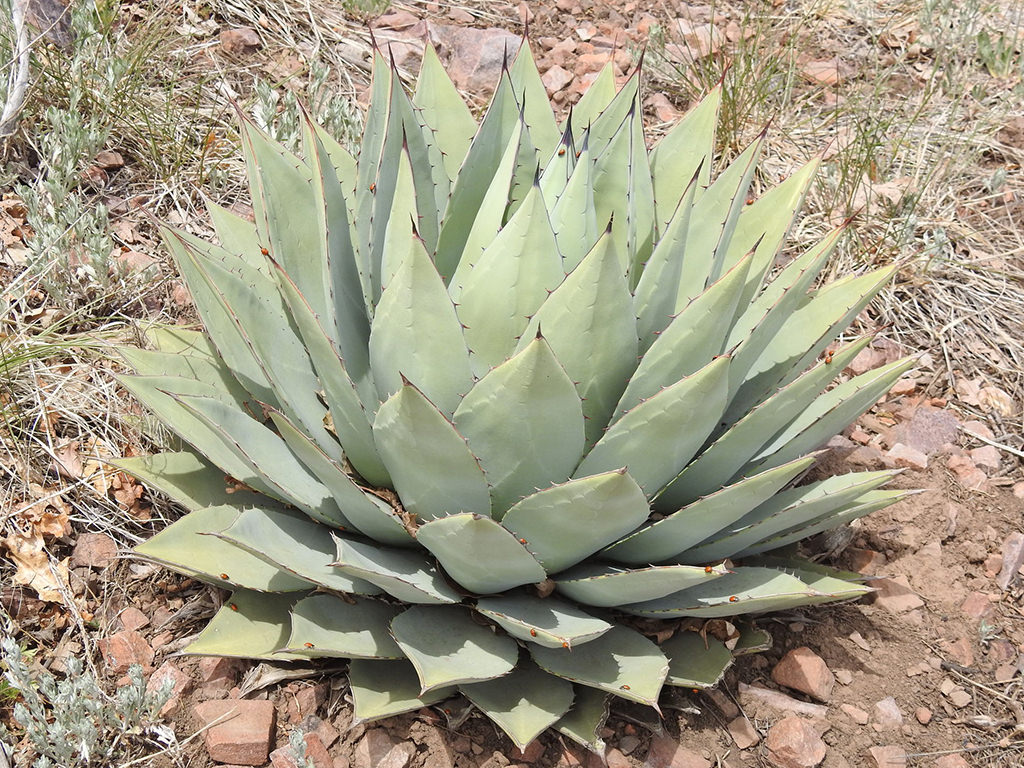Scientific Name
Agave parryi Engelm.
Common Name(s)
Mescal Agave, Parry's Agave, Parry's Century Plant
Synonym(s)
Agave applanata var. parryi, Agave leopoldii, Agave parryi subsp. parryi, Agave parryi var. parryi
Scientific Classification
Family: Asparagaceae
Subfamily: Agavoideae
Genus: Agave
Description
Agave parryi is a slow-growing succulent that forms attractive symmetrical rosettes of blue-gray to gray-green leaves with spiny margins and a dark brown to gray terminal spine. The rosettes grow up to 2 feet (60 cm) tall and up to 3 feet (90 cm) in diameter, producing offsets at the base and forming a colony of rosettes over time.
The spectacular flowering spike emerges from the center of the mature rosettes, usually after 10 and 15 years. It grows up to 20 feet (6 m) tall, producing 20 to 30 branches with large clusters of pale yellow flowers. The rosettes die after flowering.
Origin
Agave parryi is native to Arizona, New Mexico, and northern Mexico. It is typically found at elevations that range from 4,000 to 8,000 feet (1200 to 2400 m).
Etymology
The specific epithet "parryi (PAIR-ree-eye)" honors Charles Christopher Parry (1823-1890), a British-born American botanist, plant collector, and mountaineer.

How to Grow and Care for Agave parryi
Light: Like all Agaves, this plant requires full sun to partial shade. If you are growing A. parryi indoors, choose a bright, sunny window with as much sun as possible. From spring to fall, it loves going outside.
Soil: A. parryi will tolerate most soils as long as they have good drainage, but its preference is sandy or rocky soil.
Hardiness: During the growing season, it likes warm temperatures, while in winter, when resting, this succulent enjoys cooler temperatures. A. parryi can withstand temperatures as low as 5 to 35 °F (-15 to 1.7 °C), USDA hardiness zones 7b to 10a.
Watering: From spring to fall, water thoroughly when the soil becomes dry. In winter, water sparingly about once a month. Plants in containers require more frequent watering than those in the ground.
Fertilizing: Give your A. parryi a small amount of fertilizer in the spring during the first two years. Established plants seem to take care of themselves.
Repotting: If you notice your A. parryi becoming pot-bound, repot it with fresh soil in a new pot that is just slightly larger than the old one. Give the plant a week or so to readjust before watering it again.
Propagation: Since it can take years to produce seeds, A. parryi is usually propagated by offsets. The best time to remove the offsets is in spring and summer. Sow the seeds in spring.
Learn more at How to Grow and Care for Agave.
Toxicity of Agave parryi
A. parryi is not toxic to humans but may be mildly poisonous to children and pets.
Subspecies, Varieties, and Cultivars of Agave parryi
- Agave parryi subsp. neomexicana
- Agave parryi subsp. neomexicana 'Sunspot'
- Agave parryi var. couesii
- Agave parryi var. huachucensis
- Agave parryi var. truncata
- Agave parryi var. truncata 'Huntington'
Links
- Back to genus Agave
- Succupedia: Browse succulents by Scientific Name, Common Name, Genus, Family, USDA Hardiness Zone, Origin, or cacti by Genus
Photo Gallery
Click on a photo to see a larger version.



